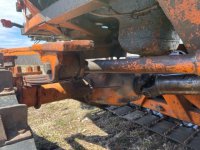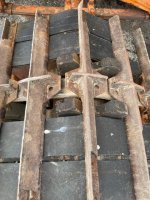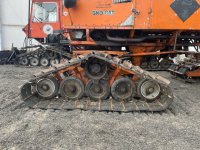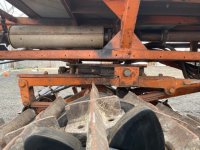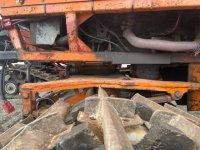The washers are sold in pairs, or at least they are when bought from the factory. There is an inner washer with a larger ID and the outer washer has a smaller ID.
I bought new tie rod ends from Rock Auto, and tried to save The Infamous WBJ1 some bucks by purchasing the Ultra Power brand economy versions. That was a mistake as the rubber boots have disintegrated before the machine has even been used.
There is a left hand and a right hand threaded end, and you'll need one of each per tie rod. The part numbers I bought were ES187R and ES187L The tie rod ends have 1 1/8"-12 threads. If you look up a 1983 Ford L-Series truck, that will get you in the ballpark but confirm the thread configuration before ordering.
HOWEVER, these part numbers were used on a 1980 vintage machine, and Tucker may have used different versions on yours.
When you start the process of replacing tie rods you may soon be challenging your vocabulary of four letter words. Getting the old ones out can be a downright bear of a job. When we did it, we bought taps to chase the threads on the tie rods themselves and liberally used anti-seize on the new ones.
You will also want to follow Tucker's alignment procedure to get the steering correct. DON"T just count threads and assume it was done properly when the machine was assembled.
The photo of the carrier shows the UHMW track slides are either missing completely, or worn to nothing. Those should definitely be replaced. You can buy new from Tucker and pay handsomely, or buy some UHMW plastic and make your own. The small square ice blockers also look they they may be due for replacement.
If the journals are worn on the carrier and/or the axle housing, you should consider buying some bearing tape to make up for at least some of the wear. I bought bearing tape from Tucker, Inc, but of course there are other sources.
I don't know how far down the rabbit hole of repair/maintenance you want to go. When we remove carriers with the intention of going through them, we will remove all the spindles from the tubes, clean the spindles and spindle tubes and coat them with anti-seize prior to reassembly. Those spindles, like the tie rod ends, have tendency to get rusted/corroded in position and can be very difficult to remove. VERY!
Doing so now is preventive maintenance. If an idler wheel bearing gets loose, it can damage the idler wheel and the spindle, and that can mean spindle replacement. It's hard enough to fight the spindles in the comfort of your shop with all your tools and resources available. Now think about having that fight in the middle of nowhere, on your back, in the snow and having a hard time swinging a hammer to persuade that stuck spindle to cooperate. I've mentioned this in a previous post or two, and some forum members disagree with doing this. Obviously, it's up to you, but I wanted to at least make you aware of the situation.

